Recognizing the next seven top performers of the 2023 season.
June 13, 2023 by Jenna Weiner and Keith Raynor in Awards with 0 comments
Each year, Ultiworld presents our annual College Awards. Our staff evaluates the individual performances of players from throughout the season, talking to folks around college ultimate, watching film, and look at statistics, voting upon the awards to decide those to be honored. The regular season and the college Series are both considered, with extra emphasis for performances in the competitive and high-stakes environment at Nationals.
Our All-American teams recognize the top performers across the division. While in the past we have closed our Awards with our First Team and Second Team, displaying the top seven and next seven players who had the best seasons, they have been moved up in the schedule. As our voting process is ordered, the top two vote-getters for All-American honors, excluding the Player of the Year, will be recognized as our Player of the Year runner-ups. As such, those three players are listed in order, with the runners-up identified; the other four players are listed in alphabetical order.
- Player of the Year
- All-American First Team
- All-American Second Team
- Breakout Player of the Year Award
- Rookie of the Year Award
- Offensive Player of the Year Award
- Defensive Player of the Year Award
- Coaches of the Year Award
D-I Women’s All-American Second Team

Dawn Culton (North Carolina)
It might be a surprise to see last year’s Callahan winner and POTY dropping to the head of the second team this time around. However, when the bar is set that high even a fantastic season can feel like a letdown. Don’t take this as any indictment on Culton’s play, though, as she remains the premier defender in the division, and her offensive capabilities have only grown year over year. If UNC wanted to effectively erase a player off the field this year, Culton remained their go-to answer to smother the other team’s best player. Then, after a turn, the classic Conerly-Culton connection was made with regularity as the Pleiades pressed their advantage.
In a hypothetical draft of the most impactful players in the division, the former POTY seems a near lock to be among the top few selections. Such is her gravity on the field, and at this point her luminosity should be unquestioned. And while she may have appeared to shine not quite as clearly this season amidst the Pleiades’ field of stars, Culton still dazzled brilliantly all the same.
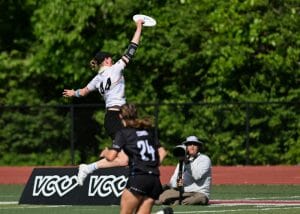
Stacy Gaskill (Colorado)
Most players who only play one regular season tournament for their team don’t then finish as an All-American. Then again, most players aren’t Stacy Gaskill. Colorado’s Olympian and Ultiworld’s 2022 DPOTY once again held things down for the Quandary defense, and her pulls remained second-to-none. However, offensively is where Gaskill’s game really took a step forward this season, as she simultaneously cut down her turnovers while pouring in both goals and assists.
It’s easy to point to Gaskill’s athleticism as the key to her game, and while yes, she remains arguably one of the most physically gifted athletes in the sport, there is still plenty of nuance to how Gaskill plays. As Colorado’s often default deep defender in their zone looks, Gaskill has a honed sense of where danger might be coming from and plenty of ability to then shut it down. And on offense, while the “jump balls to Stacy” strategy works well and regularly for Quandary, Gaskill is also plenty happy to grind the underneath spaces, dish some off-hand backhands, and keep the Colorado offense going. In limited minutes this season, it was Gaskill’s across-the-board contributions, then, that helped elevate her to All-American recognition once again.

Julia Hasbrook (UC Santa Barbara)
There are an abundance of cliches we use for superstar players: put the team on their back, willed their team to the win, a takeover or do-it-all player, etc. They’re cliches for a reason, but for Julia Hasbrook they ring true all the same.
Take the Burning Skirts’ peerless handler’s performances against Carleton and Stanford. Both games that UCSB ended up losing on universe point, but both extremely impressive showings nonetheless from the lower seeded Skirts and their top thrower. In each game, Hasbrook threw over half of UCSB’s assists, with eight in a 15-14 pool play loss to Syzygy, and seven in UCSB’s 14-13 prequarters defeat to their regional rivals Superfly. All told, Hasbrook averaged over six assists per game and finished with 31 total over the course of the weekend, good for second in the division. Add in her team-leading 12 blocks, and you start to get a picture of a player who could put her team on her back with her array of throws, who could do it all on offense and on defense, and who could clearly be included as one of the best players in the division.
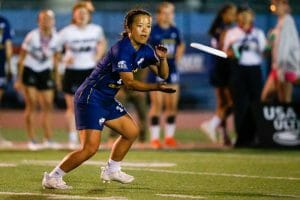
Madison Ong (UBC)
It isn’t clear how Ong’s badminton background informs her ultimate game, but the connection to soccer is a little more visible. In some alternate timeline, she could a star midfielder, in another a point guard, in another a quarterback, any position where controlling the offense would be valued. Ong seems to have the game on a string, and with it, she can control the flight and velocity of a disc or manipulate and obliterate the balance of her defender.
That ability to play at varying speeds and keep defenses in react-mode made Ong a great fit in the modern style of play. Adept at breaking marks and ankles in equal measure, attacking highly guarded spaces, and tuning the pace to fit her and teammates’ needs, the UBC handler was able to bring the game to her, and help bring plenty of Ws to UBC.
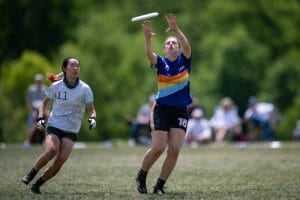
Hazel Ostrowski (Tufts)
A coach’s favorite star player is one they can plug into just about any role on the field and have that player succeed without issue. Enter Tufts’ Hazel Ostrowski, one of the best all-around contributors in the division, and Tufts’ leading light this season. Ostrowski’s Nationals 14G/17A double-double landed her in the top-20 in both categories, and only Callahan winner Abby Hecko had more goals and assists than the Tufts superstar.
This season, Ewo’s depth may have obscured Ostrowski’s overall prowess, but there were still plenty of flashes to demonstrate that this is still the player that won the 2020 ROTY and made the US U20 team in 2018. Against Oregon in a universe point pool play game, there was Ostrowski finding the end zone five times and throwing an assist to boot as Tufts secured second in Pool D. Then, while the result went well against Ewo in their game against Vermont, it was the Ostrowski show as she was directly involved in six of Tufts’ eight goals with two goals and four assists. It’s moments like those that make you sit up and recognize Ostrowski’s exceptional skill, even as she fits whatever mold is needed of her at the time.
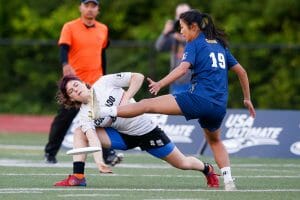
Clil Phillips (Colorado)
Sometimes, you hear about a dichotomy between people with innate talent and those who willed their way to success with hard work. But sometimes, a special athlete’s talent might just be the effort. Phillips plays the game with the urgency of a meteor hurtling towards a planet’s surface, and sometimes with the explosiveness that interaction generates, too.
Because of her high-revving motor, she generates more opportunities to apply her playmaking abilities. Few players seem to thrive on pressure the way Phillips does, who simply seems to move faster and jump higher, as if her sensei let her cast off some dense legweights to face her most challenging opponents. When a player with this much skill does nothing at half measure, you end up some one of the most feared opponents and valued teammates in the game.
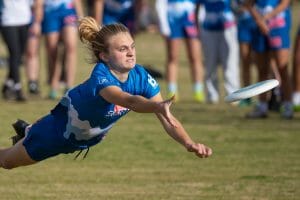
Devin Quinn (UC Santa Barbara)
A fierce cutter, Quinn went from a shockingly productive rookie (who nearly did enough to be crowned the best such player in the division last year) to star sophomore. One could say it is a pretty speedy rise up the rungs of the college ladder of stardom. That would be very appropriate if you watch Quinn play, because there’s a lot of speeding and a lot of rising going on out there.
She again led Nationals in goals1 with the same total of 22 as last year’s effort. (Could she score 100 goals at Nationals in her career? Bonkers.) But even that, six assists, and six blocks undersells her offensive impact. Quinn churned out yards time and time again, and a more dialed in ability to play in small spaces added to her effectiveness as a bailout reset or red zone threat. Her progress is commendable, but her superpowers as an offensive centerpiece are remarkable and only growing.
tying with Stanford’s Sage McGinley-Smith ↩